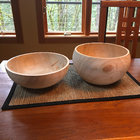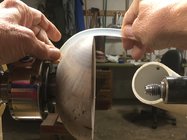For the last few months I have been turning every day. I have a few pieces of wood that I think will be really nice, and and I am working on my skills before I take them on. The winter ice storm left me with a lot of wood to practice on, pine and cedar, and maybe I will try some Doug fir. The wood presents some challenges and has helped me to refine my tool use. The latest are from one chunk of cedar tree trunk.
After they finished drying I will use shellac to stiffen the fuzzies prior to sanding. They are both 9 inches by 5 on one and 3 1/2 on the other.
After they finished drying I will use shellac to stiffen the fuzzies prior to sanding. They are both 9 inches by 5 on one and 3 1/2 on the other.


